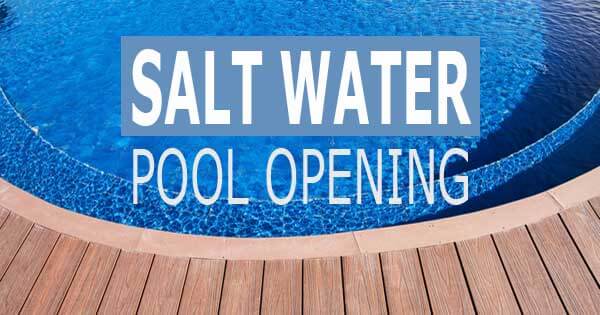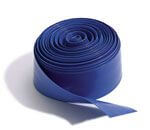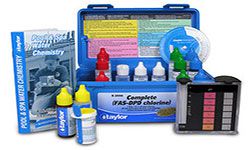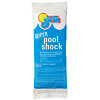How to Open a Green Salt Water Pool
 Starting up a salt water pool is similar to opening a regular pool, but there are some distinct differences that should be noted. It starts the same way as every pool opening, and ends nearly the same way – it's a few steps in the middle that require some rethinking.
Starting up a salt water pool is similar to opening a regular pool, but there are some distinct differences that should be noted. It starts the same way as every pool opening, and ends nearly the same way – it's a few steps in the middle that require some rethinking.
1. UNWINTERIZING THE POOL
You could call it summerizing the pool, un-winterizing is the reverse of the winterization. First step is to replace the plugs on the equipment. The drain plugs for the pump and filter are re-tightened, using fresh Teflon tape on the threads, and a small amount of lubricant on drain plugs with gaskets.
Next is removing the pool plugs. Your skimmers, wall returns and cleaner lines should be plugged tightly. You will know if the lines were empty if water rushes in to fill the pipes, as the plugs are removed. Use a good pool lubricant to grease-up the pump lid o-ring, and replace the pressure gauge on the pool filter.
If you removed your salt cell for the winter, place it back in place with a small bit of pool lube on the union o-rings. Tighten salt cell unions fully, and plug the salt cell to the controller. Plug the controller into the outlet, but keep the salt system OFF for now. Check over the entire system, and check tightness of all clamp bands, hose clamps, unions and other connections. Open all valves, so that the water can flow freely through the filter system.
2. STARTING UP THE SYSTEM
 Fill the pump with water, or for aboveground pools, just open the valve to flood the pump basket. Check one more time that everything is tight and all the pool plugs have been removed, and the system valves are open. If you have a multiport valve, set it to Drain to Waste position, and roll out the backwash hose. This lets you discharge the gunk and worms from skimmers and drains.
Fill the pump with water, or for aboveground pools, just open the valve to flood the pump basket. Check one more time that everything is tight and all the pool plugs have been removed, and the system valves are open. If you have a multiport valve, set it to Drain to Waste position, and roll out the backwash hose. This lets you discharge the gunk and worms from skimmers and drains.
Open the filter air relief bleeder valve on top of the filter tank, and turn on the filter pump. Run for several minutes with open all lines fully, and then empty the pump basket. After discharging the gunky water, switch a multiport valve to Filter position and turn the pump to filter position. Watch the filter pressure closely, if it spikes to over 30 psi, shut off the pump quickly, and find out why. When the air relief starts to spray water, close the bleeder valve. Inspect your filter system for anything dripping or leaking.
Do not turn on the salt cell yet!
3. BALANCING THE CHEMICALS
Before we ask the salt cell to get to work making chlorine, the water chemistry must be tested and adjusted as needed. When all the tests are in the proper ranges, your pool water can be said to be balanced. For advanced water balance computations, enter your test kit readings on the Pentair LSI calculator.
 Be sure to use a reliable test kit like the Taylor K-2005 or the 7-way test strips to measure your water balance. Test kit reagents and strips will generally last for 2-3 seasons, if kept in a dark and cool location. For saltwater pools, it is best to run a lower pH and higher alkalinity level, or pH of 7.2 – 7.4 and total alkalinity of 100-125 ppm. Calcium Hardness is also important, add calcium chloride if levels are under 180 ppm.
Be sure to use a reliable test kit like the Taylor K-2005 or the 7-way test strips to measure your water balance. Test kit reagents and strips will generally last for 2-3 seasons, if kept in a dark and cool location. For saltwater pools, it is best to run a lower pH and higher alkalinity level, or pH of 7.2 – 7.4 and total alkalinity of 100-125 ppm. Calcium Hardness is also important, add calcium chloride if levels are under 180 ppm.
Cyanuric Acid levels are very important for saltwater chlorinators. Every salt system manufacturer recommends stabilizer or conditioner to protect the chlorine from quick degradation by the sun, which causes the salt cell to overwork. 30-50 ppm is recommended, add Stabilizer if below 30 ppm.
4. SHOCKING THE POOL WITH CHLORINE
I hope you were patient, and waited to shock the pool until now! Shocking with powdered chlorine shock, or liquid bleach to super-chlorinate the pool is important to break apart contaminants and bacteria in the water that has been stagnant for so long.
 If your pool water is clean and clear, you will need much less chlorine than if your pool is green and cloudy. A clear pool can use 1 lb of pool shock per 10000 gallons, but a green pool can require 3-5 lbs per 10K gallons. Keep adding until the water turns a blue-grey color, then add a bit more for good measure.
If your pool water is clean and clear, you will need much less chlorine than if your pool is green and cloudy. A clear pool can use 1 lb of pool shock per 10000 gallons, but a green pool can require 3-5 lbs per 10K gallons. Keep adding until the water turns a blue-grey color, then add a bit more for good measure.
Test the water after 12 hours, and if the chlorine level has fallen near zero (so quickly), shock the pool again. But if you can test a good reading of free chlorine, an additional shock is not necessary, unless the water is still green.
5. TESTING SALT LEVEL
 Every salt system manufacturer has specific recommendations for the salt level, aka salinity level of the pool water. This is very important to the proper operation of a salt cell – so much that most salt systems have salt sensors and low salt indicators, and will shut down at very low salt levels.
Every salt system manufacturer has specific recommendations for the salt level, aka salinity level of the pool water. This is very important to the proper operation of a salt cell – so much that most salt systems have salt sensors and low salt indicators, and will shut down at very low salt levels.
Use a reliable salt test strip to check your salt levels. We also have salt meters that measure it electronically and display digitally. Taylor makes a dropper style tester, the very accurate K-1766 salt test kit. Even if your salt system displays a salt reading, it's a good idea to test the water.
6. ADDING MORE SALT
 Most saltwater pools need a booster dose of salt added in spring, especially if you lowered the water level for winter. This can be between 10%-20% of the entire pool water volume in most cases. This can require 1 or 2 bags of pure pool salt, like Aqua Salt. Pour around the pool edge, and use a brush to help disperse and dissolve.
Most saltwater pools need a booster dose of salt added in spring, especially if you lowered the water level for winter. This can be between 10%-20% of the entire pool water volume in most cases. This can require 1 or 2 bags of pure pool salt, like Aqua Salt. Pour around the pool edge, and use a brush to help disperse and dissolve.
Do not use solar salt or water softener salt or winter salt treat! These all contain impurities that can cause stains and may void your salt system warranty. Use only Pool Salt, do not use Food Grade salt, which may contain iodine or other additives. Pure NaOCl only – 100% sodium chloride.
7. START-UP THE SALT SYSTEM
Finally you are ready to start making your own chlorine. I assume that you have already cleaned the salt cell last fall and you don't have any scale deposits on your salt cell that could hinder chlorine production, and shorten cell lifespan!
Turn on the salt system, and set-up the sanitation modes the way that you like. Be sure to test your water several times per week, to fine tune the chlorine production levels, and maintain good pH, alkalinity and stabilizer levels for the summer.
Voila! Your salt water pool is now open. Key Takeaways of today's blog post are: Balance the water first, shock (Heavily) with chlorine second, and third, be sure the salt level is spot-on before turning on your salt cell. You coulda just skipped down to the end, but I hope you didn't!

Sheryl Somers
SPP Pool Expert
How to Open a Green Salt Water Pool
Source: https://blog.intheswim.com/pool-opening-saltwater-pool/

0 Response to "How to Open a Green Salt Water Pool"
Post a Comment